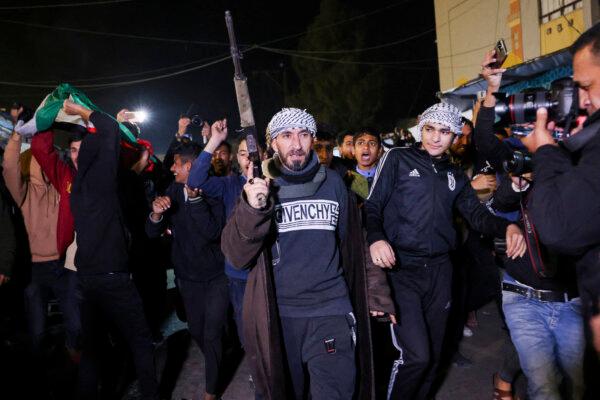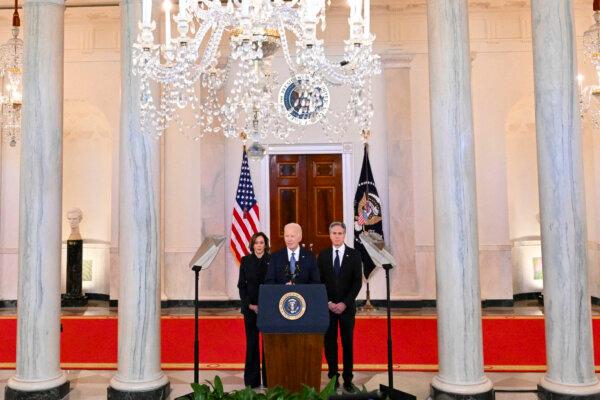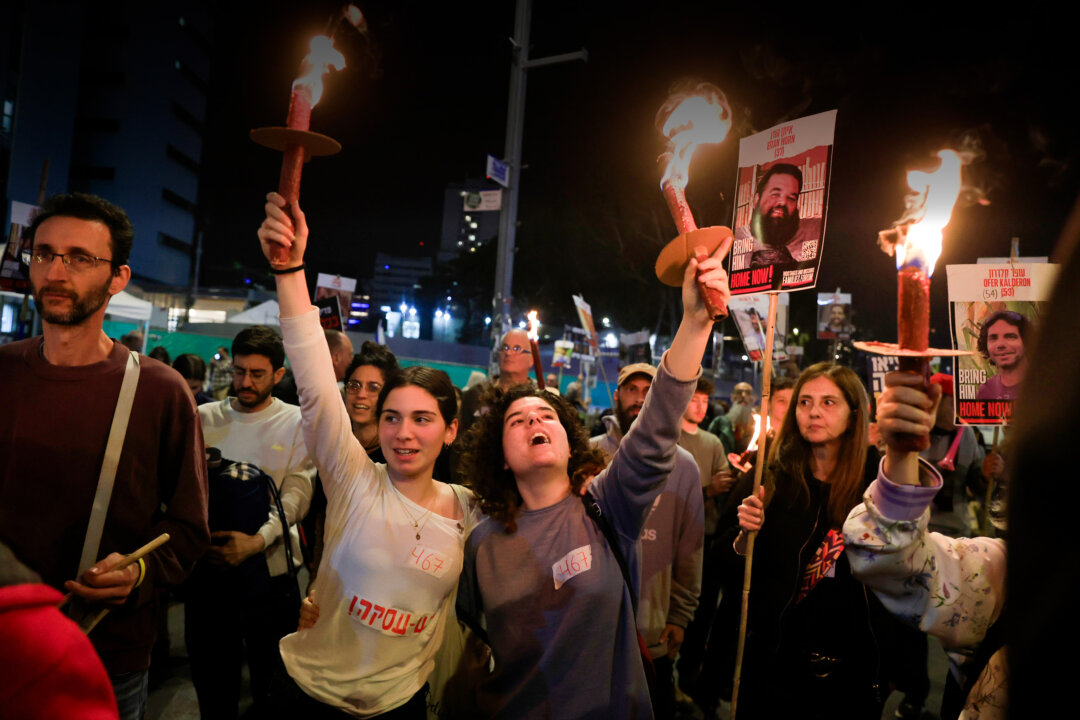Qatar’s prime minister laid down the general terms of the six-week cease-fire, which includes swapping 33 hostages for an unspecified number of prisoners.
Israel and Hamas have reached a deal, to take effect on Jan. 19, for a hostage and prisoner swap, a six-week cease-fire, and access to relief aid for the beleaguered Gaza Strip.
The deal’s details were confirmed and many of them disclosed, at a news conference in Doha, Qatar, late on Jan. 15 by Qatari Prime Minister Sheikh Mohammed bin Abdulrahman Al Thani. The negotiations, conducted around the clock in recent days, were mediated by Qatar, the United Arab Emirates, and the United States, Al Thani said.
“We worked day and night in order to reach this moment,” he said.
As part of the agreement, according to Al Thani, Hamas will release 33 Israeli captives, including civilian women, female recruits, children, elderly people, and civilians who are ill and wounded, in return for an unspecified number of Palestinian prisoners held by Israel.
Israel will withdraw toward the east, away from populated areas, he said.
“Israel force will then be positioned along the Gaza border, which will allow for the swap of prisoners, as well as the swap of [human] remains and the return of displaced people to their residences. This will also facilitate the travel of wounded and sick people in order to seek treatment,” Al Thani said.
The first phase will also see “an increased flow of relief and humanitarian aid to all parts of the Gaza Strip, as well as the rehabilitation of hospitals, health centers, [and] bakeries,” he said. It will allow the entry of fuel and civil defense equipment, “as well as basic necessities for displaced people who lost their houses as a result of the war.”
Details of the deal’s second and third phases will be negotiated during the first phase, Al Thani said.
U.S. President Joe Biden, speaking at the White House, said the first phase will include the release of American hostages. He called the negotiations “one of the toughest negotiations I’ve ever experienced.”
“And we reached this point because of the pressure that Israel built on Hamas backed by the United States,” Biden said.
Biden said his administration and the incoming team of President-elect Donald Trump were “speaking as one team” in recent days to make the deal a reality. Representatives of both the president and president-elect—Trump’s designated Mideast envoy Steve Witkoff and Biden’s National Security Council coordinator for the Mideast and North Africa Brett McGurk—have been in Doha in recent days.
Al Thani didn’t respond directly when asked by a reporter whether pressure from the incoming Trump administration helped the parties reach a deal that had stalled for more than 400 days since a brief cease-fire in November 2023 collapsed.
He credited both sides, thanking Witkoff and McGurk by name. He also said the parties “have seen a momentum that started to build in the last month.”
Trump, announcing the deal in a Truth Social post about an hour before Biden spoke, took credit for the breakthrough.
“This epic ceasefire agreement could have only happened as a result of our historic victory in November,” Trump posted on social media, “as it signaled to the entire world that my administration would seek peace and negotiate deals to ensure the safety of all Americans, and our allies.
“I am thrilled American and Israeli hostages will be returning home to be reunited with their families and loved ones.

“With this deal in place, my national security team, through the efforts of Special Envoy to the Middle East Steve Witkoff, will continue to work closely with Israel and our allies to make sure Gaza never again becomes a terrorist safe haven.”
The two Americans who will be freed in the first phase of the cease-fire will be Keith Siegel and Sagui Dekel-Chen, an administration official told reporters. In total, 33 hostages in Gaza will be released by Hamas for hundreds of Palestinian prisoners being held by Israel during the six-week phase. If negotiations are ongoing after the six weeks, the cease-fire will continue.
There will be a meeting in the Egyptian capital of Cairo on Jan. 17 to discuss how the cease-fire will be implemented, an administration official told reporters in a press call. This includes provisions related to the cease-fire, humanitarian aid to Gaza, and the release of Israel’s hostages held by Hamas in Gaza and prisoners held by Israel.
Prime Minister Benjamin Netanyahu’s office said earlier in the day that a deal had not been reached. He is set to put the deal before his security cabinet for approval at 11 a.m. local time on Jan. 16.
Hardline Israeli leaders may not approve. National Security Itamar Ben Gvir threatened on Jan. 14 to quit Netanyahu’s governing coalition over the deal.
He urged Treasury Minister Bezalel Smotrich to join him in opposing it. Smotrich, expressing opposition to the deal, hasn’t threatened to quit over it.

On Oct. 7, 2023, thousands of terrorists penetrated Israel’s border defenses, in some cases paragliding over them. They killed 1,200 people, mostly Jewish civilians but also non-Jewish Israelis and foreign farmworkers.
The attackers outmatched troops at bases that were lightly manned on a Saturday that was both the Sabbath and a Jewish holiday.
The terrorists heavily damaged certain communities such as the Kfar Aza and Be’eri kibbutzes, murdering entire families including dogs, raping, setting buildings on fire, beheading people, and setting bodies on fire.
They killed more than 300 attendees at the Nova music festival—an event promoting peace and love at a site near the border. They took 250 hostages and wounded thousands.
The IDF immediately began mobilizing for a counterattack, calling up 350,000 reservists. Ground operations began on Oct. 13, 2023, with a full-scale invasion of Gaza with the stated aim of neutralizing Hamas on Oct. 27.
Israel’s ground forces, artillery, and air attacks have laid waste to the 140-square-mile coastal strip, leaving much of it uninhabitable.
Gaza civilians face shortages of food, with many relief shipments from Israel or abroad diverted by Hamas. Many people have had to evacuate multiple times, often after IDF warnings about buildings or areas designated for attack.
Gaza’s health authorities—who do not distinguish between civilians and terrorists—said last week that more than 46,000 people have been killed in the conflict.
The IDF has said it has killed over 17,000 terrorists, with many of the remaining casualties being civilians who were used as human shields by Hamas fighters who hid in residential areas, shelters, schools, and hospitals. The IDF has also accused Gaza of inflating the numbers with people who died of natural causes.
The Associated Press and Reuters contributed to this report.

